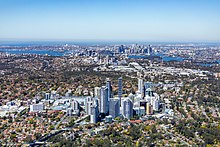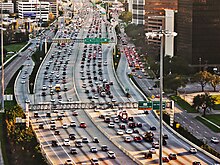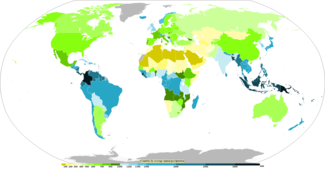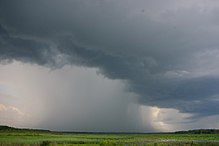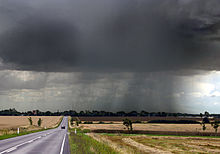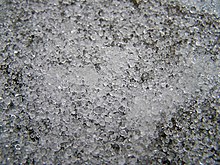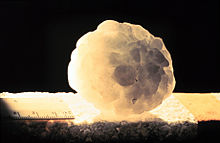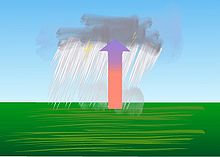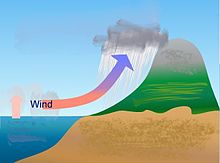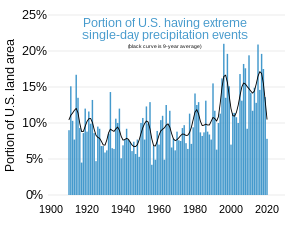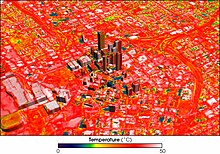In urban planning, architecture, human geography, landscape architecture, and civil engineering, the term built environment, or built world, refers to the human-made environment that provides the setting for human activity, including homes, buildings, zoning, streets, sidewalks, open spaces, transportation options, and more. It is defined as "the human-made space in which people live, work, and recreate on a day-to-day basis."
The built environment is most relevant in the fields of architecture, landscape architecture, urban planning, public health, sociology, and anthropology, among others.
The built environment is made up of physical features. However, when studied, the built environment often highlights the connection between physical space and social consequences. It impacts how society physically maneuvers and functions, as well as less tangible aspects of society such as socioeconomic inequity. The topic of the built environment also includes the ways in which communities have approached environmental issues that have arisen as a result of the altering of the natural environment for human activities. Various aspects of the built environment contribute to scholarship on housing and segregation, physical activity, food access, climate change, and environmental racism.
History
The term "built environment" places the concept in direct contrast to the supposedly "unbuilt" environment. However, taking a long-term perspective, the distinction between built and unbuilt become less clear because of the significant effect of human activity on the natural environment—whether through "clearing, terracing, ditching, planting, harvesting, fires" or from "accumulated layers of roads, bridges, dams, and buildings."
Early concepts of the built environment in urban contexts date to Classical Antiquity: Hippodamus of Miletos, known as the "father of urban planning", developed Greek cities from 498 BC to 408 BC that created order by using grid plans that arranged the city in a more structured pattern. These early city plans eventually gave way to the City Beautiful movement in the late 1800s and early 1900s, inspired by Daniel Hudson Burnham, a reformist for the Progressivism movement who actively promoted "a reform of the landscape in tandem with political change." The effort was in partnership with others who believed that beautifying American cities would improve the moral compass of the cities and encourage the upper class to spend their money in cities. This beautification process included grand baroque parks and European-inspired architectural design to emphasize ideals of European culture as a supposed improvement to society. By mid-19th century, modernist or "indifferent" design influenced the character of work and public spaces, followed by a late twentieth century "revival of interest relating to the concept of place (including the built environment), and its relevance to mental health and other fields of study."
The built environment has significant social implications as well as physical ones. Concern with the built environment can be found in anthropological literature as early as the early 19th century in studies of social and cultural history. Early theories recognized that shelter and city organization was not only utilitarian, but reflected the culture of the societies that erected it. Durkheim, a foundational sociological theorist, similarly recognized that spatial organization is both a product of social factors but also plays a role in reproducing social forms.
Modern built environment
Currently, the built environment is typically used to describe the interdisciplinary field that encompasses the design, construction, management, and use of man-made physical influence as an interrelated whole. The concept also includes the relationship of these elements of the built environment with human activities over time—rather than a particular element in isolation or at a single moment in time, these aspects act together via the multiplier effect. The field is generally not regarded as a traditional profession or academic discipline in its own right, instead, it draws upon areas such as economics, law, public policy, sociology, anthropology, public health, management, geography, design, engineering, technology, and environmental sustainability. Within the field of public health, built environments are referred to as building or renovating areas in an effort to improve the community's well-being through construction of “aesthetically, health improved, and environmentally improved landscapes and living structures”. For example: a community forest user group in Nepal is a multidimensional institution, which provides goods and services to local communities through natural resource management (see Climate change adaptation in Nepal).
Technology is playing a pivotal role in shaping the industries of today by augmenting processes, streamlining activities, and integrating innovations to propel the functioning of companies and organizations across a multitude of industries and help them achieve new heights. Building information modeling is prominent practice. It involves illustration & pre-execution overview of the physical and functional characteristics of places. BIM tools help the planner in making a future ready informed decision regarding a building or other built asset. Smart Building Management, Drone-based Surveying, 3D Printing, and Intelligent Transportation System are recent implementations of technology that serve as proof that the modern built environment is not always physically influenced in the digital age.
Prominent features of the built environment
Transportation options
Transportation options within a community play a large role in communities, both socially and physically. These options can include roads, sidewalks, and public transportation infrastructure.
Roads and highways
Roads allow pedestrians and people operating vehicles (whether cars, buses, motorcycles, or bicycles) to reliably access all areas of an urban or regional space. For millennia, road systems have served as the veins of urban spaces, allowing people to travel efficiently between areas within a city or region. Roads circulate people and materials throughout cities, just as "the cardiovascular network distributes energy and materials to cells." Without well-planned roadways, cities operate as collections of smaller isolated neighborhoods with little movement between them to stimulate city-wide economic growth and the socioeconomic mobility of households. While primarily intended to promote transit, can also serve as physical barriers in the built environment. One study out of Cornell University used U.S. Census data to compare the differences between linear distance and distance-by-road in American cities. The results found that road distance was disproportionately high between clusters of different racial groups, while it is much closer to linear distance within neighborhood clusters. Major roadways can also divide social space by reducing walkability and separating business from residential areas.
Sidewalks
Sidewalks are an important feature of the built environment that enable pedestrian mobility and increase walkability. Urban road networks used to be primarily a place for the pedestrian, but have become increasingly dominated by automobiles. The city sidewalk, therefore, is a place safe for bipedal commuters. The quality and service of sidewalks can be impacted by factors like police patrolling, cleanliness, obstructions, and damage to the surface such as cracks. Walkable neighborhoods are proven to be safer and more accessible, with the presence of many pedestrians creating a watchful community. Businesses also benefit from increased foot-traffic near their establishments that encourages people to stop and shop more frequently than if they were driving past the store.
Public transportation
Public transportation is an essential part of urban spaces and the built environment. Public transport raises property values by improving access to surrounding resources, lowers the cost of living by reducing the need for a car, and improves an area's environmental footprint by reducing carbon-rich greenhouse gas emissions. Studies show that land use and transit infrastructure has a great impact on the use of public transit in cities globally. Individuals' decisions to either drive, walk, bike, or use public transit are shown to be influenced by spatial factors such as density.
Research also shows that the availability and nature of bike lanes and trails impacts cyclist numbers and behavior. When the proper infrastructure is implemented, residents are likely to utilize the amenity. However, the construction of bike lanes in America has sometimes been recognized as a symbol of gentrification, as it attracts younger white residents and impacts a location's demographics because of the benefits to the neighborhood.
Buildings
At their most basic level, buildings are used as spaces of shelter for residential and business uses. They are one of the most clear elements of the built environment because of their physical presence and purpose to protect against the natural or "un-built" environment. The location, design, and layout of buildings all have an impact on the function and effectiveness of a building's service as an aspect of the built environment. A building's location can influence its function, and how frequently it is used by people. Additionally, the design of indoor space, as determined by architects and designers, has a great impact on how the space functions and the behavior it promotes.
Parks and green space
Parks provide a number of neighborhood benefits including promotion of physical activity and environmental wellbeing. The location and accessibility of parks also has a great positive influence on the surrounding communities. For example, the addition green spaces to urban space can combat air pollution, provide a break from otherwise monotonous urban networks, and even impact city-wide temperatures by reducing the Heat-island effect.
Impact of the built environment
Housing and segregation
Features in the built environment present physical barriers which constitute the boundaries between neighborhoods. Roads and railways, for instance, play a large role in how people can feasibly navigate their environment. This can result in the isolation of certain communities from various resources and from each other. The placement of roads, highways, and sidewalks also determines what access people have to jobs and childcare close to home, especially in areas where most people do not own vehicles. Walkability directly influences community, so the way a neighborhood is built affects the outcomes and opportunities of the community that lives there. Even less physically imposing features, such as architectural design, can distinguish the boundaries between communities and decrease movement across neighborhood lines.
The segregation of communities is significant because the qualities of any given space directly impact the wellbeing of the people who live and work there. George Galster and Patrick Sharkey refer to this variation in geographic context as "spatial opportunity structure," and claim that the built environment influences socioeconomic outcomes and general welfare. For instance, the history of redlining and housing segregation means that there is less green space in many Black and Hispanic neighborhoods. Access to parks and green space has been proven to be good for mental health which puts these communities at a disadvantage. The historical segregation has contributed to environmental injustice, as these neighborhoods suffer from hotter summers since urban asphalt absorbs more heat than trees and grass. The effects of spacial segregation initiatives in the built environment, such as redlining in the 1930s and 1940s, are long lasting. The inability to feasibly move from forcibly economically depressed areas into more prosperous ones creates fiscal disadvantages that are passed down generationally. With proper public education access tied to the economic prosperity of a neighborhood, many formerly redlined areas continue to lack educational opportunities for residents and, thus, job and higher-income opportunities are limited.
Public health
Historically, action-oriented initiatives to the built environment have often stemmed from issues with public health. Dating back to Georges-Eugene Haussmann's comprehensive plans for urban Paris in the 1850s, concern for lack of air-flow and sanitary living conditions has inspired many strong city planning efforts. Public health research has expanded the list of concerns associated with the built environment to include healthy food access, community gardens, mental health, physical health, walkability, and cycling mobility. Designing areas of cities with good public health is linked to creating opportunities for physical activity, community involvement, and equal opportunity within the built environment. Urban forms that encourage physical activity and provide adequate public resources for involvement and upward mobility are proven to have far healthier populations than those that discourage such uses of the built environment.
Physical activity
Since, the built environment determines how people move throughout a given space, it influences public health by promoting or discouraging health and wellness. Research has indicated that the way neighborhoods are created can affect both the physical activity and mental health of the communities’ residents. Built environments purposefully designed to improve physical activity are also linked to higher rates of physical activity, which in turn, positively affects health. People are generally more active in densely populated areas, areas good street connectivity, and mixed-use communities which incorporate both retail and residential space. As a result, those who prefer to walk and live in walkable environments often have lower obesity rates and drive less compared to those who preferred living in auto-dependent environments.
Neighborhoods with more walkability have lower rates of obesity, as well as increased physical activity among its residents. They also have lower rates of depression, higher social capital, and less alcohol abuse. Walkability features in these neighborhoods include safety, sidewalk construction, as well as destinations in which to walk. In addition, the perception of a walkable neighborhood, one that is perceived to have good sidewalks and connectivity, is correlated with higher rates of physical activity.
Assessments of walkability have been completed through the use of GIS programs, such as the Street Smart Walk Score. This example of a walkability assessment tool determines distances to grocery stores and other amenities, as well as connectivity and intersection frequency using specific addresses. Assessments such as the Street Smart Walk Score can be utilized by city and country planning departments to improve existing walkability of communities.
To implement walkable neighborhoods, community members and local leaders should focus on policy development. An effective framework that has been utilized in an abundance of communities is the Complete Streets concept of community planning that has been developed by the National Complete Streets Coalition (NCSC). NCSC states that the most successful policies are those that reflect input from a broad group of stakeholders, including transportation planners and engineers, elected officials, transit agencies, public health departments, and members of the community. According to Riggs, 2016, policies may focus on a “Complete Streets” investment, which includes sidewalk bulb-outs and refuges to reduce crossing distances or street widths for pedestrians. Other investments should include installing crosswalks, road markings, benches, shelters and sidewalk art installations. Every community will have a unique method of policy development depending on whether it is an urban, suburban, or rural community and how the policy will combine the variety of transportation modalities. Communities may choose to focus on walkability, but will also need to consider biking, wheeling/rolling, driving, and emergency vehicles. The NCSC policy workbook gives descriptive guidance on how to proceed with policy development whether they be council-driven, council-approved, directives, or citizen vote. When deciding how to proceed with walkability policy development, considerations should be made regarding current and past transportation policies, local community and government support, and how transportation policies have been implemented in the past.
Public health also addresses additional components of built environments including “cycling mobility”, which refers to the access that an area has granted to safe biking through multiple bike paths and bike lanes. Both walkability and bikeability have been cited as determinants of physical activity.
Built environments containing recreational facilities have been associated with greater physical activity among children. For example, one study found that walking paths, parks with playgrounds, swimming areas, basketball courts and other various recreational facilities increased physical activity among adolescent girls. Urban planning and its utilization of mixed use development are key factors affecting childhood obesity. Mixed use spaces are composed of residential, commercial, cultural, and institutional components. This type of development helps to reduce the distance residents have to travel to access a grocery store or school. It also creates a more walkable and bike friendly environment for residents.
It has been proven that high-density environments, meaning mixed use spaces and neighborhoods with higher walkability and bikeability, will increase physical activity. A multivariable cross-sectional study done by the Harvard School of Public Health examined the association of walkable built environment characteristics with body mass index (BMI) scores among a large sample of children and adolescents. A series of geographic information system variables were used to characterize a walkable built environment.
- A distance of less than 15 km to a private or public recreational open space has been linked to an increase in physical activity among children. This may be due to the influence children have on one another when they see others playing.
- Also, a higher number of open spaces increases the likelihood of physical activity among children.
- A more densely populated residential area can increase children's proximity to their peers creating a more walkable environment.
- Less traffic density can also increase physical activity among children because their parents feel safe when they are walking in the neighborhood.
- Lower neighborhood speed limits with more sidewalks and intersections also create a safer environment for children increasing their likelihood to walk in the neighborhood.
- Finally, a greater variety of land use mix, or mixed use spaces, results in more children walking.
These built environment characteristics that can increase walkability were found to be generally associated with a lower BMI scores among the children sampled. Another study looking at active commuting, those reporting walking, biking, or skateboarding to school more than three times a week, among elementary aged children had significantly lower BMI than non-active commuters. For these reasons, mixed use lands within the built environment are imperative to helping address childhood obesity. Urban sprawl, which has been positively associated with increased obesity, and an overall decline in active transportation in recent decades presents a real need for improving health within the built environment. High-density environments bring schools, parks, and grocery stores closer to residents making it convenient to potentially eat healthier foods and exercise on a regular basis. Comprehensive urban planning, such as mixed use development, promotes healthier lifestyles in general.
The strength of the evidence for reducing obesity through the environment has been highlighted by the Centers for Disease Control in its Common Community Measures for Obesity Prevention Project, which includes measures of healthy food access and physical activity environments. The National Institute for Health and Care Research (NIHR) has published a review of research on public health interventions to reduce obesity. The review covers interventions looking at green spaces, blue spaces, parks, roads, urban regeneration, active travel infrastructure (walk and cycle lanes), public transport, and the food environment (prevalence of food outlets).
Food access
Access to healthy food is also an important component of the built environment. A higher density of convenience stores has been associated with obesity in children. In contrast, improved access to community supermarkets and farmer's markets is correlated with lower overweight status. Specifically in low income neighborhoods, the presence of a local grocery store is correlated with lower BMI/overweight risk. Community gardens are also considered a part of the built environment, and have been shown to increase fruit and vegetable intake among gardeners. Scholars say that community gardens have also been shown to have positive social and psychological impacts that lead to lower levels of stress, hypertension, and an improved sense of wellness, affecting the overall health of the individual and the community.
Urban Metabolism and nature
The embedded presence of the built environment within nature is of considerable importance in its creation and employment for human means. The urban environment is not alien to nature, where "It is in practice, hard to see where 'society' begins and 'nature' ends'', the built environment's embedded presence is always apparent and considerable in urban planning.
As Nik Heynen describes the conditions of Jakarta's development. In the summer of 1998, the Southeast Asian financial bubble imploded. Global capital moved spasmodically from place to place, leaving cities like Jakarta with a social and physical wasteland where dozens of unfinished skyscrapers were dotted over the landscape while thousands of unemployed children, women, and men were roaming the streets in search of survival. In the meantime, El Niño’s global dynamic was wreaking havoc in the region with its climatic disturbances. Puddles of stagnant water in the defunct concrete buildings that had once promised continuing capital accumulation for Indonesia became great ecological niches for a rapid explosion of mosquitoes. Malaria and Dengue Fever suddenly joined unemployment and social and political mayhem in shaping Jakarta’s cityscape.
— Heynen, Nik & Kaika, Maria & Swyngedouw, Erik., In the Nature of Cities - Urban Political Ecology and The Politics of Urban Metabolism. (2006).
Considering the 'urban metabolism', these interactions remind designers how cities and urban centers exist as "dense networks of interwoven socio-spatial processes that are simultaneously local and global, human and physical, cultural and organic".


